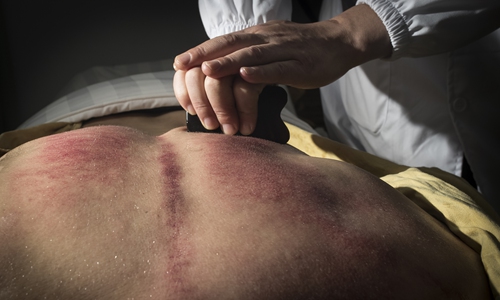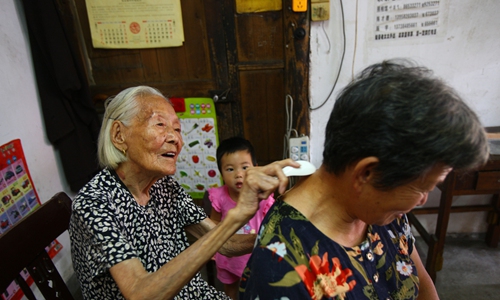Gua sha facials: just hype, or does it really work?
By Bi Mengying Source:Global Times Published: 2020/4/16 23:10:08

Redness resulted from gua sha Photo: VCG
Hailed as "the original form of at-home self-care," or "a lymph-flushing skin care darling" for its "surprising beauty benefits," gua sha has created a media stir with many major skin care brands pairing gua sha facial tools with their products.
Gua means scraping in Chinese, and sha refers to disease. It usually involves repeatedly scraping along the skin with a piece of smooth wood or, if you have the money, jade. While the resulting redness that often appears after a treatment can appear somewhat frightening, this treatment goes far beyond skin deep.
The concept of gua sha is closely related to the body's acupoints and meridians - the invisible energy pathways that run through the body to channel one's life energy in Traditional Chinese Medicine (TCM). If anything that disrupts the smooth flow of that energy, clogged pools of energy can form leading to an illness. Gua sha is seen as a way to scrape or smooth out these clogged pools and get energy flowing again.
"Gua sha was really frowned upon and made fun of [in the West] up until very recently. It wasn't the trendy, desirable thing. It is now all over social media and wellness blogs," said Ivy Lee, a Chinese-American acupuncturist in a video posted on Instagram in February, speaking up about the cultural appropriation of gua sha.
She noted that in the predominately white wellness industry in the US, it could be considered inauthentic and disrespectful for non-Asian wellness practitioners and companies to claim their Gua sha-related products or services are "the only" or "the first," or try to teach or sell a misinformed or diluted version of gua sha without understanding tradition.
Cultural barriers
The story depicted in The Gua Sha Treatment, a Chinese film released 20 years ago, poses a stark contrast for gua sha's perception in the West in relation to its current popularity.
Screened at the Cannes Film Festival, the movie depicts a grandfather from the Chinese mainland in the US using gua sha to treat his grandson, who has a fever. The temporary bruising and redness on the child's back left by the treatment was misconstrued to be evidence of child abuse, which leads the family to be taken to court.
In the judge's chambers, the father Xu Datong tries to explain the body's complex network of energy pathways, but the English-speakers either do not have the patience to listen to what the father is saying or are unable to understand the explanation, which leads to an unfortunate lawsuit that tears apart the family.
The film has been chosen by some Chinese teachers for intercultural communication-related courses as it dramatizes the cultural misinterpretations about gua sha and other issues that were common in the West.
Some who have watched the film said they sympathize with the cultural plight of the Chinese immigrants, while some pointed out that the misunderstanding regarding gua sha hints at the larger misconception about Chinese culture in general and the inequality of cultural power between countries. The gua sha facials currently trending in the West are making some people wonder, are they advocating authentic gua sha used in TCM or simply exploiting a tradition they don't understand for profit?

Cheng Xingmei, who's over 100 years old, gives gua sha by using a spoon in East China's Ningbo on August 5, 2016. Photo: VCG
Cultural appropriation or adaptation?
Scraping areas on the face does indeed exist in TCM gua sha, but this form of gua sha is very different from the traditional gua sha applied to other areas on the body that most Chinese know about or practice, Sun Haishu, an attending physician at the TCM Clinic of the China Academy of Chinese Medical Sciences in Beijing, told the Global Times.
Sun explained that gua sha for face isn't commonly used for treating diseases; rather it is categorized as a cosmetic treatment under TCM. While it can be used to treat diseases such as melasma, usually it is sufficient to scrape the face until the skin feels slightly warm, rather than waiting until redness or bruises appear as is preferred in gua sha on other areas of the body.
The various materials used as scrapers can vary according to type of treatment as well as the wealth of those undergoing gua sha.
Legends tell of empresses and concubines in ancient China using pieces of jade to scrape their face, which can be considered as a form of gua sha.
While rose quartz stone and jade seem to be trending choices for gua sha facial tools in the West, Sun noted that other materials can be used depending on the circumstances. Copper, horns of some animals, pointed stones, and various metals such as gold are just some examples. But the most typical material in ancient times was jade.
A risky scam?
The average score of the 218 reviews for the six listings of gua sha facial tools and products on popular US cosmetic retailer Sephora's website as of Thursday was 4.4/5.
Some dermatologists say gua sha facials have little effect, explaining that studies have shown impressive results for traditional body gua sha, but not treatments for the face. Some experts have even raised strong opposition against gua sha facials.
"Gua sha is truly one of the worst skin care treatments I've seen in awhile. I have no words for how terrible it is for your skin because it's so easy to overdo and increase the risk of damage," said US business woman Paula Begoun, founder of skincare brand Paula's Choice, in an interview with Indian magazine Brides Today in March.
Known as "The Cosmetics Cop" in the beauty world, Begoun claims that gua sha "almost instantly generates inflammation." Pointing to a gua sha video online, she argued that the model's skin is clearly turning red during the scraping process, a sign of inflammation rather than healthy blood flow.
"It is advised to be cautious when dealing with the danger zone triangle of the face. Other than that, in most cases, there isn't any risk for doing a gua sha facial, even if you do it at home," Liu Pangong, an attending physician at the Beijing First Hospital of Integrated Chinese and Western Medicine, told the Global Times.
Given how it stimulates the facial muscles, acupoints and meridians and blood circulation and its removal of clogs in the meridians, both Sun and Liu agree that gua sha facials can be beneficial as a form of at-home self-care so long as the proper methods are followed.
Sun further added that if one can learn more about TCM theory, that would surely be better. Acupoints, meridians, the strength of scrapping, the materials and oils used, the physical condition of individuals; there are many variables involved in gua sha.
"TCM has a truly long history. For the average person in China, it would take some effort to learn about it. As such it may be difficult to understand in the West. Different epistemologies result in different methodologies… Looked at in a positive light, the questioning and disputes concerning gua sha probably show people's desire to know more about TCM theory," Sun noted.
Gua sha is not the only type of TCM that the West has been showing an interest in.
Sun gave an example about the spike in interest in cupping therapy after US swimmer Michael Phelps was seen with large purple circles across his back and shoulders. Phelps went on to win a gold medal at the Rio Olympics in 2016. Sun said that given such interest in the TCM treatment, hopefully it may be a matter of time before the West understands and recognizes the health benefits that TCM theory and application can offer.
Posted in: CULTURE & LEISURE